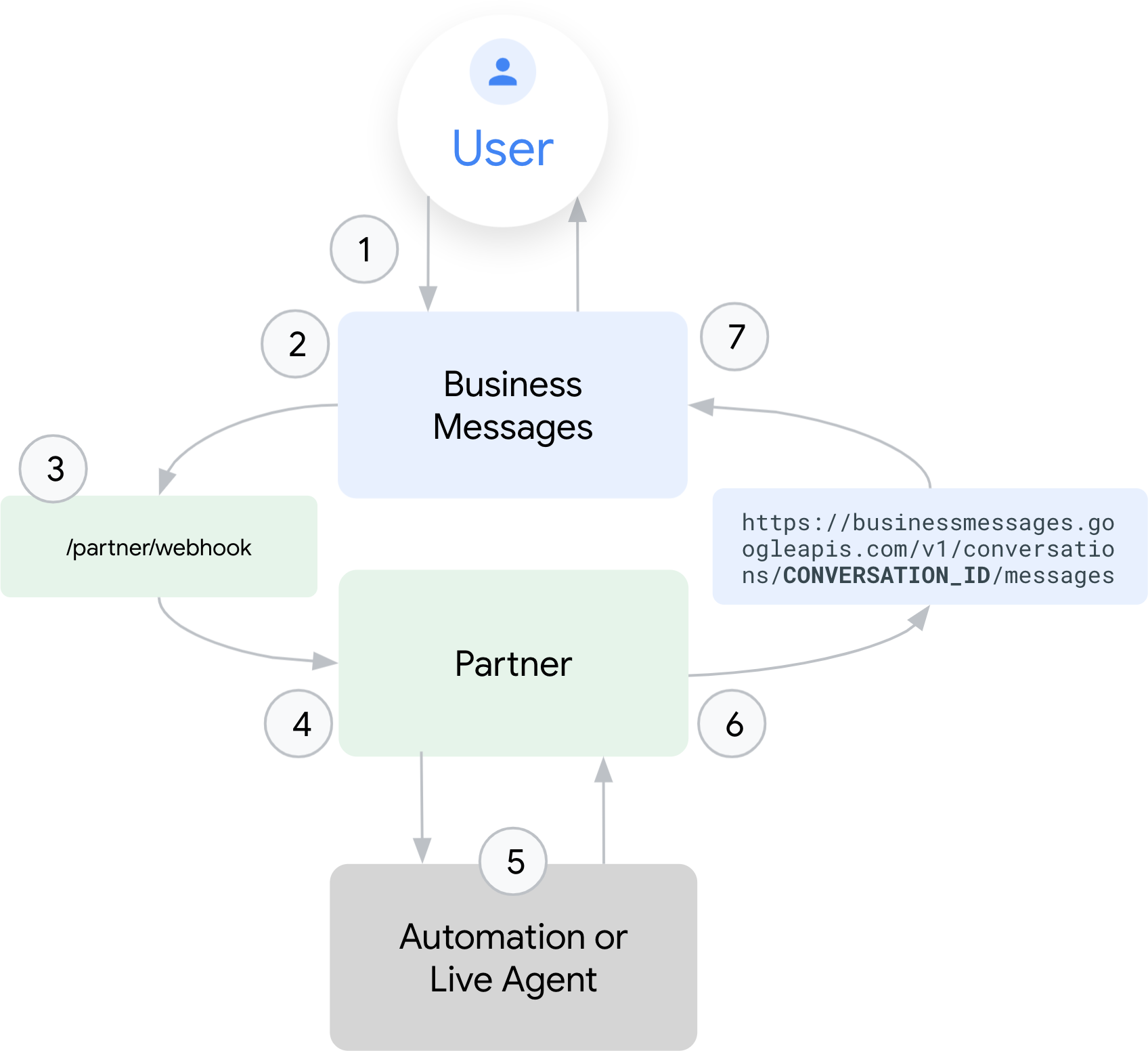Người dùng có thể gửi tin nhắn cho nhân viên hỗ trợ và nhân viên hỗ trợ có thể gửi tin nhắn cho người dùng, nhưng không chỉ thực hiện nhiều thao tác như vậy. Đối với mỗi thông báo, có thể có nhiều bên tham gia:
- Người dùng bắt đầu cuộc trò chuyện với một nhân viên hỗ trợ thông qua các điểm truy cập trên Tìm kiếm, Maps và các đường liên kết cũng như trang web do thương hiệu quản lý. Người dùng phải đăng nhập vào Tài khoản Google, nhưng chỉ tên của người dùng được chia sẻ với đối tác. Thông báo cho người dùng được mã hóa bằng TLS (Bảo mật tầng truyền tải).
Business Messages hoạt động như một lớp giữa người dùng và đối tác để bảo vệ quyền riêng tư của người dùng. Lớp này đảm bảo thông tin Tài khoản Google của người dùng không được chia sẻ với đối tác hoặc nhân viên hỗ trợ trực tiếp bằng cách giải mã và mã hoá lại từng tin nhắn đến và đi, đồng thời ánh xạ Tài khoản Google của người dùng với mã nhận dạng cuộc trò chuyện.
Google lưu trữ các thư được mã hoá để đảm bảo việc gửi và đồng bộ hoá giữa các thiết bị của người dùng. Không thể chia sẻ những tin nhắn đã lưu trữ này với bất kỳ bên thứ ba nào. Bạn chỉ có thể truy cập bằng mã Google của người dùng.
Tác nhân là nội dung đại diện cho một thương hiệu, do đối tác tạo và quản lý.
Đối tác quản lý nhân viên hỗ trợ thay mặt cho một thương hiệu. Đối tác nhận được tin nhắn đến tại một webhook đã chỉ định, định tuyến tin nhắn đến đối với tính năng tự động hoá hoặc nhân viên hỗ trợ trực tiếp để soạn phản hồi và gửi tin nhắn đi đến API Business Messages.
Tính năng Tự động hoá xử lý các thông báo cho người dùng mà không cần họ tương tác.
Tác nhân trực tiếp xử lý các tin nhắn của người dùng yêu cầu sự tương tác của con người.
Mỗi bên đóng vai trò quan trọng trong việc gửi và nhận tin nhắn trong một cuộc trò chuyện. Quy trình nhắn tin hai đầu bắt đầu bằng việc người dùng nhắn tin cho nhân viên hỗ trợ, và kết thúc bằng việc người dùng nhận được phản hồi của nhân viên hỗ trợ.

- Người dùng bắt đầu một cuộc trò chuyện và gửi tin nhắn cho một nhân viên hỗ trợ của Business Messages.
- Business Messages gán mã nhận dạng cho cuộc trò chuyện. Mã cuộc trò chuyện luôn tồn tại và duy nhất đối với người dùng và nhân viên hỗ trợ. Nếu cùng một người dùng đã liên hệ với một nhân viên hỗ trợ khác, thì cuộc trò chuyện đó sẽ có mã cuộc trò chuyện khác.
- Tính năng Business Messages gửi tin nhắn được mã hoá đến webhook của đối tác. Tin nhắn này chứa mã cuộc trò chuyện riêng, mã nhân viên hỗ trợ, mã tin nhắn và thông tin bối cảnh về nơi bắt đầu cuộc trò chuyện.
- Đối tác nhận được tin nhắn và chuyển tin nhắn đó cho tính năng tự động hoá hoặc cho nhân viên hỗ trợ trực tiếp.
- Tính năng tự động hoá sẽ tự động tạo phản hồi cho thông báo cho người dùng hoặc một tác nhân trực tiếp có quyền truy cập vào cuộc trò chuyện sẽ thấy thông báo cho người dùng và tạo phản hồi tương ứng.
- Đối tác gửi phản hồi cho API Business Messages và cung cấp mã nhận dạng cuộc trò chuyện với vai trò người nhận.
- Business Messages giải mã và mã hoá lại tin nhắn, liên kết mã nhận dạng cuộc trò chuyện với Tài khoản Google của người dùng rồi gửi tin nhắn đó cho người dùng.
